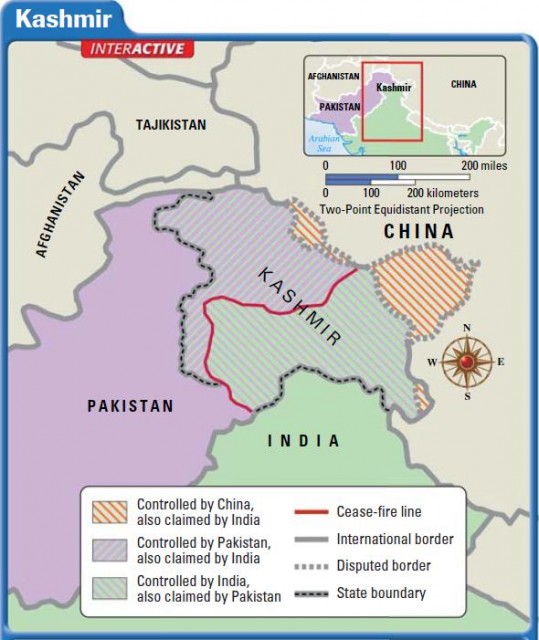South Asia: Territorial Dispute
Kashmir is a territory of towering mountains, dense forests, and fertile river valleys. It is strategically located at the foot of the Himalayas and is surrounded by India, Pakistan, and China. Since 1947, India and Pakistan have fought to control this territory of 12 million people. The territorial dispute has caused three Indo-Pakistani wars and, in just the last decade alone, cost up to 75,000 lives. It poses a threat to the political stability of South Asia and the economic well-being of the countries involved. And, because both India and Pakistan have nuclear weapons, the Kashmir conflict has the potential to lead to nuclear war.
A Controversy Over Territory
In 1947, the British government formally ended its colonial rule over the Indian subcontinent after 90 years. It partitioned, or divided, the subcontinent into two independent countries. India had a predominantly Hindu population.
Pakistan was mostly Muslim. Britain gave each Indian state the choice of joining either country or remaining independent. Muslim states joined with Pakistan, while Hindu states remained part of India. Kashmir, however, had a unique problem.
POLITICS AND RELIGION
Kashmir was mainly Muslim, but its leader, the Maharajah of Kashmir, was a Hindu. Faced with a difficult decision, the maharajah tried to keep Kashmir independent. But the plan failed. The maharajah then ceded Kashmir to India in 1947, but Pakistani soldiers invaded Kashmir. After a year's fighting, India still controlled much of the territory. Since then, India and Pakistan have fought two more wars, in 1965 and in 1971. Although a cease-fire was signed in 1972, the situation remains unresolved. As you can see on the map below, India and Pakistan each control part of the disputed territory. Even China controls a portion, having seized a remote northern mountain area in 1962.
A QUESTION OF ECONOMICS
There's more to this conflict than just politics and religion. The Indus River flows through Kashmir, and many of its tributaries originate in the territory. The Indus is a critical source of drinking and irrigation water for all of Pakistan. As a result, the Pakistanis are unwilling to let India control such a vital resource. Kashmir has become a strategic prize that neither country is willing to give up.
A Nuclear Nightmare
In 1998, India and Pakistan each tested nuclear weapons. The rest of the world was horrified by the thought that the 50-year-old dispute over Kashmir might finally end with vast areas of South Asia destroyed by nuclear bombs. After the tests, both nations vowed to seek a political solution to the conflict. But the possibility of a nuclear war has made the dispute even more dangerous.
Despite frequent cease-fires, the border clashes have continued. Also, Pakistan is supporting Muslims in Kashmir who have been fighting Indian rule since the late 1980s.

A QUESTION OF PRIORITIES
Both India and Pakistan have large populations and widespread poverty. The money that they have spent on troops, arms, and nuclear programs might have been used to educate millions of children and to address many social problems.
Resolving the status of Kashmir would offer the people of India, Pakistan, and Kashmir the peace they need to begin improving the quality of their lives. It would also reduce political tensions in the region. The Case Study Project and primary sources that follow will help you to explore the Kashmir question.
- South Asia: Living with Extreme Weather
- South Asia: Population Explosion
- South Asia: Sri Lanka and the Maldives
- South Asia: Nepal and Bhutan
- South Asia: Pakistan and Bangladesh
- South Asia: India
- South Asia: Human–Environment Interaction
- South Asia: Climate and Vegetation
- South Asia: Landforms and Resources